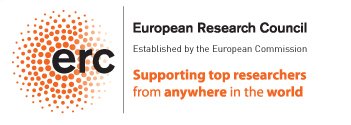
ERC TIME-BRIDGE
ERC funded Starting Grant under the framework of the EU's Horizon 2020 Programme granted in 2014 to Dr. B. Grabowski.
The main aim of TIME-BRIDGE is to design novel methodologies that will enable a more realistic simulation of materials. These simulations will open the pathway to a further improvement of materials properties such as, e.g., strength or deformability. Present-day atomistic simulations face the enormous challenge of bridging the time scale from the atomic motion—i.e., thermal vibrations which happen on the time scale of femtoseconds—to the time scale of seconds where processes relevant for materials properties take place, the so-called rare events. The main idea of TIME-BRIDGE is to develop a special type of potentials that treat the troublesome thermal vibrations in an effective manner. Such potentials are known from the field of electronic structure calculations where they replace effectively the electronic motion. Within TIME-BRIDGE this concept is transferred to the atomic motion.
TIME-BRIDGE does not exclusively focus on the time scale bridging potentials. It is strategically structured into three pillars out of which the potentials are one pillar. A second pillar focuses on bridging the length scale. Similarly as for the time scale, there is a large gap between the length scale accessible in atomistic simulations and the length scale relevant for many materials properties. We are working, for example, on developing new and improved atomic interactions or on coupling the atomistic domain to larger length scale continuum approaches. Finally, the third pillar of TIME-BRIDGE is a complementary experimental branch. In this part, we perform idealized experiments that will serve as a well-defined reference to our new atomistic approaches, allowing to scrutinize critically their performance.



